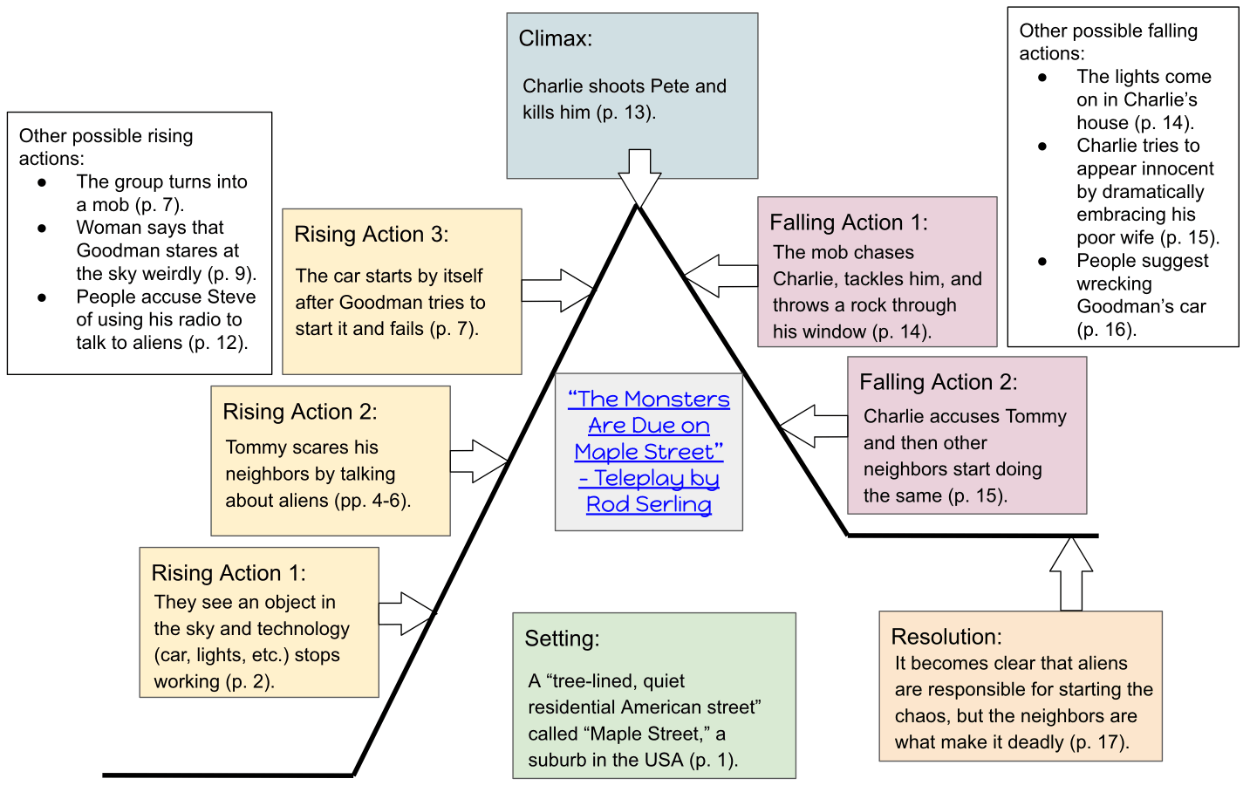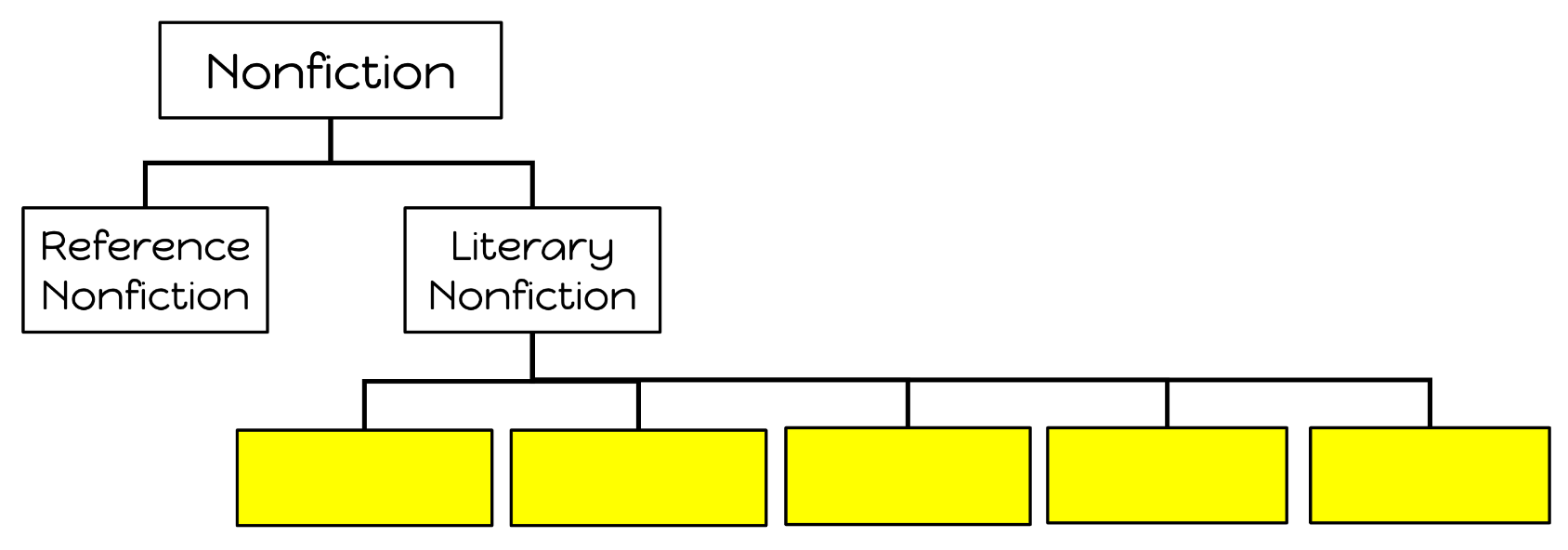Fill in the blanks below with "theme" and "central idea":
_______ is USUALLY found in fiction, while _______ is USUALLY found in nonfiction.
1. Theme
2. Central Idea
The narrator of a poem is called the ________.
Speaker
Which of the following is NOT an element of fiction?
Character, plot, conflict, claim, point of view, setting, style, theme
Claim
What are the THREE "fix-it" strategies that you should use when you don't understand what you just read? (Hint: Look at your Lesson 1 notes from last Thursday's class)
1. Reread the text
2. Use context clues
3. Mouth the words to yourself
What of the following is NOT a reason that authors use text features (such as bold, italics, captions, diagrams, and headings)?
a) To grab the reader's attention or highlight something important
b) To make the text longer or more difficult to understand
c) To organize sections of information and make the text easier to navigate
d) To help readers visualize what the text is explaining or clarify an idea
b) To make the text longer or more difficult to understand
What are the THREE types of author's purpose?
1. To inform or teach
2. To entertain
3. To persuade or convince
The End-of-Grade (EOG) Reading Test is given to all public school students in Grade 3 through Grade __.
8
The person who tells the story is called a(n) ________.
Narrator
A _______ is more general and usually can be applied to real life, not just the text or story.
Theme
Read the excerpt from the poem below “Do Not Go Gentle Into That Good Night” (1947) by Dylan Thomas. What is the poem's central message?
1 Do not go gentle into that good night,
2 Old age should burn and rave at close of day;
3 Rage, rage against the dying of the light.
4 Though wise men at their end know dark is right,
5 Because their words had forked no lightning they
6 Do not go gentle into that good night.
The poem encourages people who are dying—the sick and the elderly—to fight bravely against death. It also celebrates the vibrancy (liveliness) and energy of human life, even though it is fragile and short.
This image is an example of a ___________.

Plot Map / Plot Diagram
Fill in the blanks for the strategies below:
Strategy #1 - Chunk and Check
“Chunk” the text to break it into smaller parts so you can ________ to make sure you ________ what you just read.
Strategy #2 - “Look For” List
Look at the questions ________ reading the passage so you can create a “look for” list to use as you ________.
1. stop
2. understand
3. before
4. read
How is an essay organized?
Introduction (with thesis statement)
Body Paragraphs
Conclusion
What are the TWO ways you can use text evidence in your writing or explanations?
1. Quote (author's words)
2. Paraphrase (your own words)
True or False?
The EOG includes "field test items," which are questions that will not be included as part of students’ final scores but will be used for developing items for future test forms.
True
________ means to express the author's words' meaning in different words, often to make it easier to understand.
Paraphrase
Which of the sentences below shows theme and which shows central idea for "The Lion King"?
_______ - A young lion cub rises up to defeat his evil uncle and reclaim the kingdom.
_______ - Everyone has to eventually leave childhood behind to face adult responsibilities.
1. Central Idea
2. Theme
Read the poem below "Dreams" by Langston Hughes. How does the speaker use TWO examples of imagery to support the central message that the reader should not give up on their dreams?
1 Hold fast to dreams
2 For if dreams die
3 Life is a broken-winged bird
4 That cannot fly.
5 Hold fast to dreams
6 For when dreams go
7 Life is a barren field
8 Frozen with snow.
At the end of the play "The Monsters Are Due on Maple Street," what conclusion do the aliens come to about humanity?
“We’ll go from one to the other and let them destroy themselves” (p. 17).
That humanity is its own worst enemy and can be destroyed by itself, without weapons (such as guns or bombs, often used in war).
Describe a test-taking strategy that we did NOT cover in class with the EOG Review Packet.
CANNOT list any of these strategies:
1. Chunk and Check
2. “Look For” List
3. Take Notes / Annotate
4. Rephrase or Rewrite
5. Cover the Choices
List ALL FIVE types of literary nonfiction.

1. Narrative
2. Biography
3. Memoir (Autobiography)
4. Speech
5. Essay
Why is it important to use text evidence?
To support your reasoning, explanation, or claim/argument.
The Reading EOG for Grades 3-5 has a total of 6 passages and 48 questions, while the Reading EOG for Grades 6-8 has a total of 7 passages and ___ questions.
52
A technique that an author uses to try to persuade the reader towards considering a topic from a different perspective is called a ________ ________.
Rhetorical Device
Julia’s report card reflected poor grades. She felt she would get in trouble, so she hid her report card from her parents. When her parents discovered what her grades were, they grounded her for trying to hide the truth.
What is the theme of this paragraph?
The truth always comes out in the end
Read the poem below "Fire and Ice" by Robert Frost. Why is it important for the reader to know that it was published in 1920 after the end of World War I?
1 Some say the world will end in fire,
2 Some say in ice.
3 From what I’ve tasted of desire
4 I hold with those who favor fire.
5 But if it had to perish twice,
6 I think I know enough of hate
7 To say that for destruction ice
8 Is also great
9 And would suffice.
Because poem's message is that the world will end either by "fire" (people taking violent actions such as war) or "ice" (people taking no action at all).
A(n) ________ character is one who DOES NOT HAVE have any significant change in character, personality or perspective throughout a story, while a(n) _______ character DOES have a significant change in character, personality or perspective throughout a story
1. Static
2. Dynamic
What THREE big things should you annotate when reading a text? (Hint: Look at your Lesson 3 notes from Monday's class)
1. Important information
2. Answers to questions
3. Your personal thoughts and opinions
What makes literary nonfiction different from reference nonfiction?
Literary nonfiction gives factual information in an entertaining (story-like) way, while reference nonfiction just gives the factual information.
Read the short passage below. What is the author's most important purpose for writing the selection?
A wave is any movement that carries energy. Some waves carry energy through water. Others carry energy through gases, like air, or solid materials. If you drop a rock into a pool of water, a wave, or ripple of energy, skims across the pool's surface. In the same way, an underwater earthquake can release energy into ocean water. Then it carries a giant wave, or tsunami, across the surface until it hits land. If you hear a clap of thunder, sound waves (or vibrations) have carried the crashing BOOM to your ears. Sound waves speed through the air at about 1,100 feet (335 meters) per second. Light also travels through the air in waves. They travel at more than 186,000 miles (300 million meters) per second. So the light waves from a flash of lightning reach your eyes before that clap of thunder reaches your ears! Electrons travel in waves, too. They move back and forth in a solid wire, sending waves of electricity so you can turn on a light during the storm!
To inform readers about different kinds of waves
There are 4 achievement levels on the Reading EOG: Not Proficient, Level 3, Level 4, and Level 5. The approximate "percent correct cutoffs" for each level are:
Not Proficient = 0% - ___%
Level 3 = ___% - 70%
Level 4 = 71% - 88%
Level 5 = 89% - 100%
Not Proficient = 0% - 66%
Level 3 = 67% - 70%
Level 4 = 71% - 88%
Level 5 = 89% - 100%
A conclusion reached using evidence and reasoning that is not clearly (explicitly) stated to the reader is called a(n) ________.
Inference
True or false? The "central idea" is also known as the "topic" of the text.
False!
Central ideas are explained in a full sentence, while topics are usually one word (such as "Courage," "Kindness," "Acceptance," or "Honesty).
Read the poem below "Fire and Ice" by Robert Frost. What does "fire" represent and what does "ice" represent?
1 Some say the world will end in fire,
2 Some say in ice.
3 From what I’ve tasted of desire
4 I hold with those who favor fire.
5 But if it had to perish twice,
6 I think I know enough of hate
7 To say that for destruction ice
8 Is also great
9 And would suffice.
Fire = Desire (and the noisy, violent destruction it causes)
Ice = Hatred (and the quiet, subtle destruction it causes)
The terms "Round" and "Flat" describe a character's complexity, layers, or personality, while the terms "static" and "dynamic" describe a character's __________________________________.
development over time (throughout the story).
Which strategy did we learn in Lesson 4 on the EOG Review Packet? (Hint: Look at your Lesson 4 notes from Monday's class)
Strategy #4 - Rephrase or Rewrite
List THREE examples of reference nonfiction and THREE examples of literary nonfiction.
Reference Nonfiction: How-to books, cooking recipes, textbooks, news articles, research papers, etc.
Literary Nonfiction: Essays, speeches, narratives, memoirs (autobiographies), biographies, etc.
In nonfiction argumentative writing, writers make claims and support them with evidence. As a reader, it is important to pause while reading and ask this question: "____ ____?"
"So what?"
The NC Standard Course of Study (also known as NCSCoS) for middle school Language Arts is divided into 4 different "strands," even though the EOG only focuses on reading. Can you guess the other 3?
1. Writing
2. Speaking and Listening
3. Language
A(n) ________ is the focus statement of an essay which the point of view or discussion in the essay is based upon.
Thesis